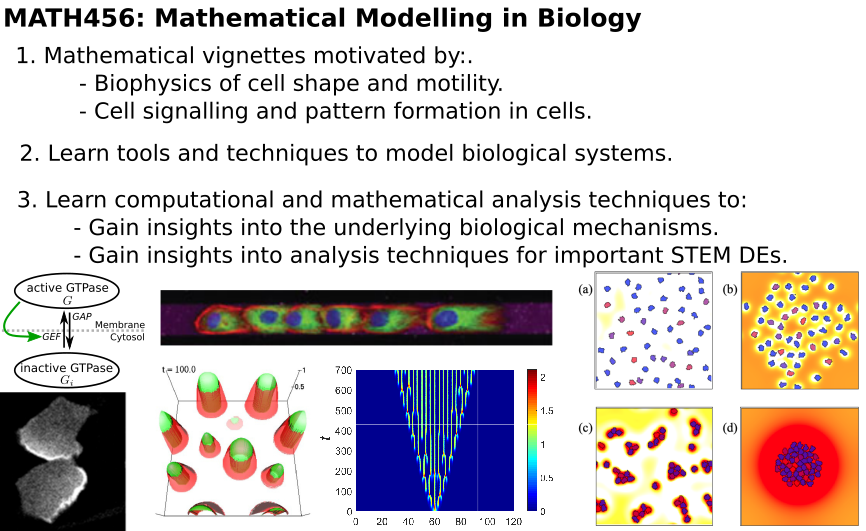MATH 456 Mathematical Modeling (Math-Bio)
Undergraduate course, University of Massachusetts Amherst, Department of Mathematics and Statistics, 2025

Course Organizational Details
- Course time: MW 2:30 - 4:00 PM
- Course location: LGRT 206
- Course text: Students receive links to evolving lecture notes, and to various files and publications to read.
Course Description
This course introduces mathematical approaches to modeling cellular phenomena, from subcellular dynamics to tissue formation. Students will develop skills in formulating and analyzing mathematical models using differential equations to understand biological systems. The course emphasizes both analytical techniques and computational methods to explore complex biological processes such as cell movement, signaling, and pattern formation. Through hands-on computational labs and project work, students will gain experience implementing and visualizing mathematical models of cellular behavior.
This course satisfies the upper-division Integrative Experience (IE) requirement. Students will have structured opportunities to reflect on connections between their General Education courses and the focused work in their major, apply critical thinking to complex problems in mathematical biology, and engage in collaborative projects addressing real-world biological questions.
Topics
This course introduces mathematical approaches to modeling cellular phenomena, from subcellular dynamics to tissue formation. Topics can be adjusted based on student interest.
- Introduction to Cell Biology and Mathematical Modeling
- Motion in Biological World (Life at low Reynold’s number)
- Introduction to dynamical systems
- Introduction to modelling in biology (parameter estimation, dimensional analysis)
- Cell signaling and biological switches
- Introduction to systems of differential equations
- Examples: The toggle switch, Fitzhugh-Nagumo, the BIG Topp model
- Introduction to computational tools in dynamical systems
- Introduction to Spatial Subcellular Dynamics
- Cell structure and simple models for biopolymers
- Random walks and their applications
- The thermal ratchet
- Multicellular Systems
- Models of cell-shape.
- Agent-based models
- Cell-cell interactions
- Introduction to tissue-level modeling
Project Work
A major component of this course is a final project where students will:
- Select a biological phenomenon of interest
- Develop appropriate mathematical models
- Analyze the models using analytical and/or computational techniques
- Present their findings in a written report and oral presentation
Project work includes proposal development, regular check-ins, and final presentations in the last weeks of the semester. This project-based approach provides students with an integrative experience that connects mathematical theory with biological applications, encouraging creative problem-solving and effective scientific communication.
